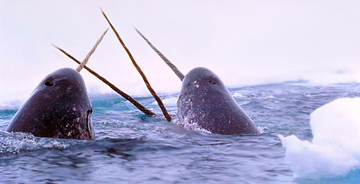The Pacific Northwest may have its legends of Bigfoot, but the waters of the Arctic have a legendary creature of their own: a creature with a big tooth that may have helped inspire tales of unicorns.
 Narwhals breaking the surface to breathe. Credit: Glenn Williams, Wikimedia Commons
Narwhals breaking the surface to breathe. Credit: Glenn Williams, Wikimedia CommonsThis remarkable creature is a type of whale known as a narwhal. It lives in Arctic waters north of the Atlantic Ocean. It comes close to shore in summer, but moves deep into the pack ice in winter, surfacing in cracks and open spaces. It spends much of its winter time diving for food. Narwhals routinely reach depths of a couple of thousand feet, and the deepest dive yet observed is more than a mile.
What really sets the narwhal apart, though, is its tusk. Adult males have a long, thin spiral-shaped tusk that can stretch six to eight feet or even longer. It’s actually a tooth that grows through the upper jaw and lip. And anthropologists say it’s at least partly responsible for legends of unicorns; when a narwhal tusk washed ashore, it was considered the remnant of those mythological creatures.
The full purpose of the tusk is still being debated. It may be largely for show, like the mane of a lion. Young males sometimes rub their tusks together like two fencers crossing swords, but they don’t actually fight with them. And a few years ago, a study found that the tusks are lined with millions of nerve bundles, allowing the narwhal to sense changes in temperature, pressure, and salinity. That makes the tusk a practical structure for a marine creature that inspired legends.

